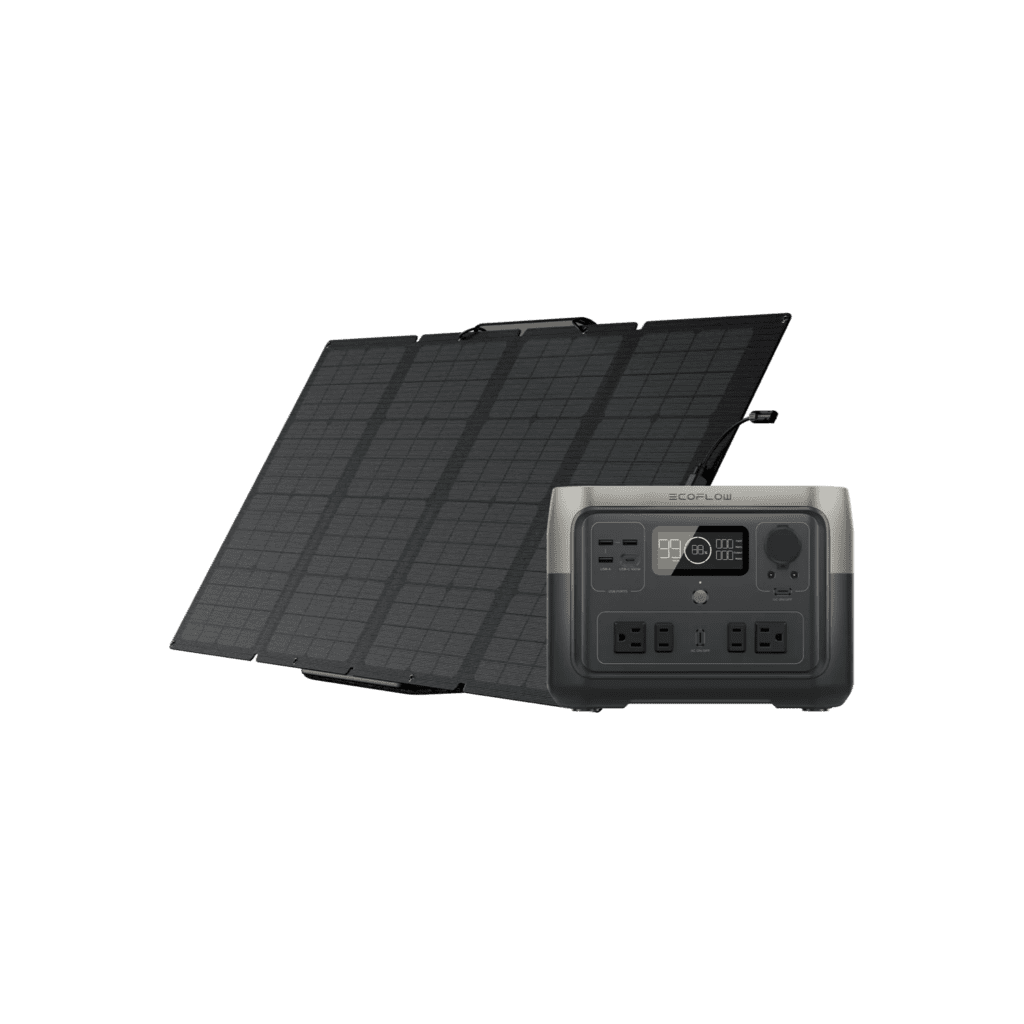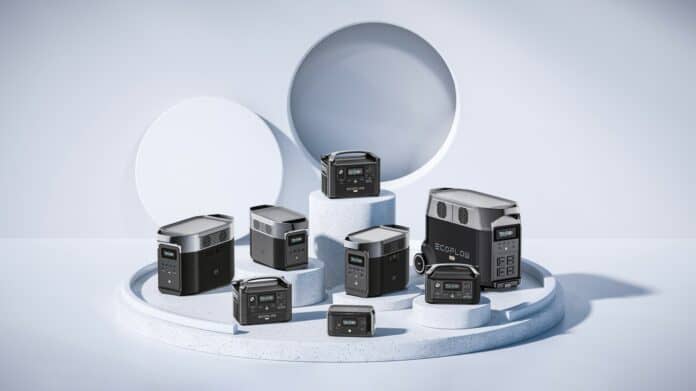More than ever in today’s fast-paced, unpredictable world, we need reliable energy. When the electric grid goes down, the food in the fridge needs to stay cold, and your devices need to remain powered. Even if you’re taking an off-grid vacation, it’s not uncommon to need your laptop in tow for work emergencies.
A solar generator lets you stay electric and connected while causing far less environmental damage than a gas option. It’s a fantastic way to reduce your reliance on an aging and increasingly overtaxed energy grid and a smart economic choice to save some cash on your next energy bill.
However, not every solar generator has the power to keep your devices running — or even get them started.
So, what size solar generator do you need?
We answer that question with our experts weighing in on how different Ecoflow solar generators can meet all your energy needs. We also provide a comprehensive breakdown of how to calculate generator size accurately.
Use this guide to help purchase the solar generator that’s perfect for you.
How Are Solar Generators Sized?
When discussing the size of solar generators, industry experts generally don’t mean the dimensions. Instead, they are talking about the capacity.
A generator’s capacity is measured in watts and watt-hours. The wattage indicates the amount of power used in energy transfer. The greater a solar generator’s capacity (i.e., the more watts it has), the more power it can provide you in a single charge.
However, it’s not enough to know a generator’s capacity because power transfer doesn’t always occur at an even rate. You need to know whether a generator’s capacity is sufficient to run the device and start it up.
There are two primary forms of watt measurement that are worth noting: continuous power and peak power.
Continuous Power
The first measurement is continuous power. This term refers to the amount of energy a solar generator can provide consistently.
Continuous power indicates how much energy you’ll get from a single charge of your power station under normal conditions. This figure also determines the run-time for operating a device.
Peak Power
The other kind of power is peak power, also called surge power or peak surge. It refers to the maximum energy a solar generator can deliver in a short burst.
The most critical time that a generator’s peak power comes into play is when you first start a device. Think about a refrigerator. These large devices constantly run throughout the day on continuous power. However, to start up, a short burst of energy is required that’s often seven times greater than the continuous power the device needs to run. That’s peak power.
With solar generators, it’s essential to consider the appliances you’d like to charge both in terms of how much electricity they require to keep running and how much power you’ll need to get it started.
How Big of a Solar Generator Do I Need?
Knowing how big of a solar generator to buy is based on your individual needs. Are you heading out into the wilderness with your laptop in tow? Or are you trying to power an air conditioner in the hot summer months and looking for ways to lower your energy bill? There are different energy solutions for different energy needs.
The two solar generators from EcoFlow below demonstrate the different-sized solar generators available and the types of devices and appliances they can power.

EcoFlow RIVER 2 Max with a 160W Portable Solar Panel
Consider the EcoFlow RIVER 2 Max with a 160W Portable Solar Panel. It has a 512Wh capacity, with four AC outputs that can each provide 800W.
The EcoFlow RIVER 2 Max can power a 50″ 110W television for 4.5 hours on a single charge or a 160W refrigerator for 3.2 hours. Going off-grid with the EcoFlow RIVER 2 Max, you’d be able to bring your 60 Wh Laptop to a full charge eight consecutive times. If you’re traveling lighter but don’t want to go entirely off the grid, you can recharge an 11Wh smartphone 46 times.
Recharging the solar generator is easy. Recharge with a 160 W Solar Panel to refuel your EcoFlow RIVER 2 Max in 4 hours.
EcoFlow DELTA Max + 400W Portable Solar Panel
One of our most powerful solar generators yet, the EcoFlow DELTA Max comes equipped with two different capacity options, one for 1600W and another more robust option for 2000W. You can expand the capacity to 6kWh with extra smart batteries. You can also choose one or two 400W solar panels to recharge fast.
If you’re looking for a solar generator that can power your large at-home devices like your fridge or dryer, the EcoFlow DELTA Max can easily handle devices up to 3400W. It can keep a 120W refrigerator running for 14 hours or a 110W 50” television going for 15 hours. It’s perfect for keeping your home powered through a blackout.
And with the collapsible 400W solar panel, the Delta Max is perfect in multiple environments, from your home to camping and off-grid living. It’s the height of engineering, with high solar output and an efficiency rating of 23%, making it a market-leading solar solution.
How to Calculate the Optimal Solar Generator Capacity
To determine what size solar generator you need for your particular situation, you’ll need to calculate the optimal capacity based on what devices and appliances you want to charge and for how long. Use the guide below to figure out your energy needs!
What Do You Want to Power and For How Long?
Choosing the size of your solar generator depends on what you want to power and how long. Do you want to keep your refrigerator running or just have a backup energy source for your laptop should a power outage happen during work hours?
Getting an upfront estimate on how much power the devices you’re working with requires is essential. Laptops and phone chargers have much smaller energy requirements than an air conditioner or large kitchen appliance. Larger appliances will likely need a significant burst of peak power to start up.
Estimate How Much Power Your Devices Use
Once you know what you want to use your solar generator to power, it’s time to calculate how much energy you need to power them up and keep them running.
Don’t worry! There are no complex equations here. You can put your high school scientific calculator back in the desk.
To start, you need to calculate how many watts each device needs to run. The wattage number is usually listed somewhere on the device, though a quick Google search can give you a reliable estimate.
Some appliances, like a refrigerator, will show the energy requirements. Look inside your refrigerator for a sticker showing the product information.
In some cases, you might only see the energy measurement in amps. You can use this information to calculate wattage. Simply multiply the amps by the volts (also listed in the product information) to calculate the wattage.
Amps (A) x Volts (V) = Watts (W)
The next step is estimating how many hours you want to be able to use each device on a single charge. Multiply the number of hours you’ll need with the total watts for your device. The product of this multiplication is your Watt-Hours.
Watts (W) x Hours (h) = Wh
You’ll need to repeat this calculation for every item if you intend to run multiple devices and appliances.
Determine the Watt-Hours of the Solar Generator
After running through this equation for all the devices you want to charge, you’ll have the minimum watt-hours required for your energy goal. That’s the information you need to choose the right-sized solar generator for you.
Note that this is likely the bare minimum of the watt hours you’ll need, so be sure to purchase a device with additional capacity. Also, remember that the generator you choose should have adequate capacity to support the device’s continuous and peak power.
Example
So let’s put this into practice. You want to power two phone chargers and a laptop for 3 hours each. Find the total amount of Watt Hours like so:
First, calculate your total wattage. A smartphone uses about 5Wh of energy. A laptop uses about 60Wh. Multiply your two phone chargers with their watt hours and add this number to your laptop’s watt hours:
2 phones x 5Wh = 10Wh
+ 1 laptop = 60Wh
Total = 70Wh
If you want to run your devices for three hours, multiple the three devices to estimate their run times:
3 devices x 3 hours = 9 hours
Now, multiply your total watt-hours from the three devices and run time to calculate the total watt-hours you’ll need from a generator:
70Wh x 9 hours = 630Wh
Conclusion
With new, ground-breaking solar technology, there’s never been a better time to harness the sun’s natural energy. No matter your energy needs, EcoFlow has a solar generator that will work for you. Browse our selection today for solar generators for home backup power, off-grid adventures, and professional projects that require portable power solutions.
